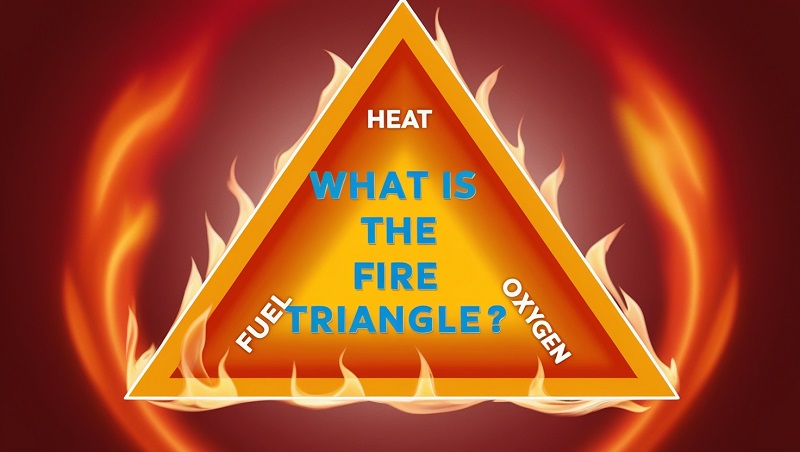The fire triangle is a simple model used to explain the essential elements required for a fire to ignite and sustain itself. Understanding the fire triangle is fundamental to fire safety, as it highlights the three components needed for combustion: heat, fuel, and oxygen. By eliminating any one of these elements, a fire can be extinguished or prevented.
This article explores the fire triangle, its significance in fire safety, and practical applications for preventing and extinguishing fires.
The Three Components of the Fire Triangle
Heat
- Heat is the energy source that initiates combustion by raising the material’s temperature to its ignition point.
- Once a fire starts, heat sustains it by vaporizing fuel and maintaining the combustion process.
- Common heat sources include matches, lighters, stoves, electrical equipment, friction, and lightning.
Fuel
- Fuel is any combustible material that provides the energy for the fire to burn.
- It can be:
- Solid: Wood, paper, cloth, plastics.
- Liquid: Gasoline, alcohol, oil.
- Gas: Propane, methane, hydrogen.
- The availability and quantity of fuel determine the fire’s size and duration.
Oxygen
- Oxygen is the oxidizing agent that supports combustion. Fire typically requires at least 16% oxygen in the air to sustain itself (compared to the normal 21% in the atmosphere).
- Oxygen feeds the fire, allowing the chemical reaction to continue. Without sufficient oxygen, the fire will smother and extinguish.

How the Fire Triangle Works
The fire triangle illustrates that fire is a chemical reaction involving heat, fuel, and oxygen. This reaction, known as combustion, produces heat and light. If any one of the three components is removed, the fire cannot exist.
Combustion Process:
- Heat raises the temperature of the fuel, causing it to release vapors.
- These vapors mix with oxygen, enabling the chemical reaction to sustain combustion.
- The reaction generates more heat, which continues to vaporize fuel and maintain the fire.
Breaking the Fire Triangle
To extinguish a fire, one of the three components of the fire triangle must be removed:
Removing Heat:
- Cooling the fire is one of the most common extinguishing methods. This is typically achieved by using water, which absorbs heat and lowers the temperature below the ignition point.
Removing Fuel:
- Without fuel, the fire cannot burn. This method involves cutting off the supply of combustible material.
- For example, creating firebreaks in wildfires removes vegetation (fuel) and prevents the fire from spreading.
Removing Oxygen:
- Smothering the fire prevents oxygen from reaching the fuel. Fire blankets, foam extinguishers, and carbon dioxide extinguishers are commonly used to displace or block oxygen.
Fire Triangle vs. Fire Tetrahedron
The fire triangle is a simplified model, but modern fire science often uses the fire tetrahedron, which adds a fourth element: chemical reaction.
The Fire Tetrahedron:
- Heat: Initiates and sustains the fire.
- Fuel: Provides energy for combustion.
- Oxygen: Supports the chemical reaction.
- Chemical Reaction: The process that allows continuous combustion.
The fire tetrahedron emphasizes that disrupting the chemical reaction (e.g., using certain extinguishing agents like dry chemicals) is another effective way to extinguish a fire.
Practical Applications of the Fire Triangle
Understanding the fire triangle has practical implications for fire prevention, safety, and firefighting:
1. Fire Prevention
- Control Heat Sources:
- Keep heat-producing appliances, like stoves and heaters, away from flammable materials.
- Regularly inspect electrical wiring and equipment to prevent overheating.
- Limit Combustibles:
- Store flammable materials like gasoline and cleaning agents in safe, sealed containers.
- Remove excess vegetation near homes to reduce wildfire risks.
- Ensure Proper Ventilation:
- Avoid storing flammable materials in oxygen-rich environments.
- Properly ventilate areas with combustible gases.
2. Fire Extinguishment
Use the fire triangle to choose the appropriate extinguishing method:
- Cooling (Remove Heat): Use water to lower the temperature.
- Smothering (Remove Oxygen): Use fire blankets, foam, or CO₂ extinguishers.
- Starving (Remove Fuel): Remove or isolate the combustible material.
3. Firefighting Strategies
Firefighters analyze the fire triangle to develop effective strategies, such as:
- Controlling the fire’s spread by creating barriers (fuel removal).
- Using water and retardants to cool the fire (heat removal).
- Deploying foam or inert gases to smother flames (oxygen removal).
Fire Triangle and Everyday Safety
In Homes
- Install smoke alarms to detect heat and smoke early.
- Keep flammable materials like paper and cleaning chemicals away from heat sources.
- Never leave cooking unattended, as stovetops are a common source of heat.
In Workplaces
- Store hazardous materials according to safety regulations.
- Train employees on fire safety practices, including how to use fire extinguishers.
- Conduct regular fire drills to ensure preparedness.
In Nature
- To prevent wildfires, avoid leaving campfires unattended and extinguish them thoroughly.
- During dry seasons, avoid activities that produce sparks near vegetation.
Conclusion
The fire triangle is a simple yet powerful concept that explains the three essential components of fire: heat, fuel, and oxygen. By understanding this model, individuals can take proactive steps to prevent fires and respond effectively in emergencies. Whether at home, in the workplace, or in outdoor environments, applying the principles of the fire triangle enhances safety and minimizes fire risks.
Remember, fire prevention is always better than firefighting. By breaking the fire triangle – removing heat, fuel, or oxygen – you can stop fires before they become life-threatening.
>>> Read more: When Should You Use a Fire Extinguisher?
